The widespread adoption of AI content generation tools has introduced a concerning phenomenon: AI slop.
This term describes low-quality, generic and often incoherent content generated by AI systems without proper human oversight or refinement.
The increase in AI slop has created significant challenges across multiple domains.
Search engines struggle to distinguish between valuable, human-crafted content and algorithmically generated text that merely fills space.
Readers encounter increasingly frustrating experiences as they navigate through seas of repetitive, shallow content that fails to address their genuine needs and questions.
Content creators find themselves competing not just with human competitors, but with an endless stream of machine-generated material that can be produced at unprecedented scale and speed.
In this guide, we will explore:
- What constitutes AI slop
- Examine its various components and manifestations
- Analyze its impact on the content creation ecosystem
- Provide actionable strategies for creating high-quality content that stands apart from the algorithmic noise.
What is AI Slop?
The term AI slop emerged from the content creation community as a way to describe the noticeable decline in content quality that accompanied the mass adoption of AI writing tools.
AI slop is not just about grammatically incorrect or factually inaccurate content. It also describes content that lacks the depth, nuance and originality associated with human essence.
This type of content often feels hollow, repetitive and disconnected from genuine human experience or expertise.
What Makes Your Content Look Like AI Slop
Understanding the specific components that characterize AI slop is essential for creators who want to avoid producing such content. These include:
1. Generic and Formulaic Language Patterns
This is one of the most recognizable aspects of AI slop.
It includes overuse of certain phrases that have become synonymous with AI-generated content, such as “In today’s digital landscape,” “It’s worth noting that,” or “In conclusion, it’s important to remember.”
These phrases, while not inherently problematic, become markers of AI slop when they appear frequently and without purpose.
Additionally, AI slop often exhibits repetitive sentence structures, predictable paragraph organization, and a lack of varied vocabulary that would naturally occur in human writing.
Here is an example of one of the generic phrases in use on a live webpage:

2. Lack of Original Insight or Perspective
This type of content often rehashes widely available information without adding new analysis, personal experience or unique viewpoints.
In cases, where the content is factually accurate, it may fail to provide readers with anything unique that they couldn’t find in numerous other sources.
This in turn contributes to information redundancy for readers.
To indicate the lack of perspective, here is a brief example with markers of an AI response to a question about the importance of email marketing to a business:
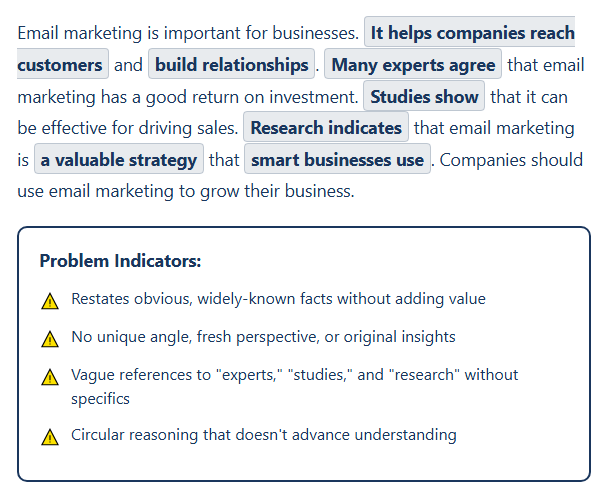
3. Superficial Treatment of Complex Topics
Most AI systems often lack the deep domain expertise required to navigate complex topics appropriately.
The result is that complicated subjects are reduced to oversimplified explanations that miss important nuances and fail to address the subtleties, exceptions or contextual factors that human experts would naturally include.
Below is a screenshot example of how this kind of AI slop manifests:
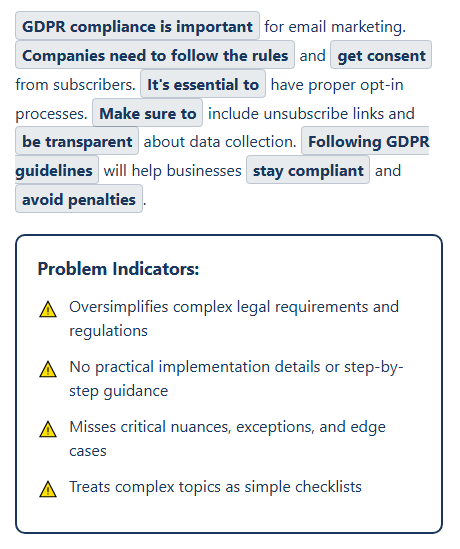
4. Inconsistent Tone and Voice
This shows as sudden shifts between formal and informal language, inconsistent use of first or third person or tonal changes that don’t align with your brand’s purpose or audience.
An example, is the screenshot below of an introduction segment about Excel workflows (quite a serious topic).
As shown, the tone jumps from casual to formal which unless it is your preferred style to produce edgy content, is something to watch for.
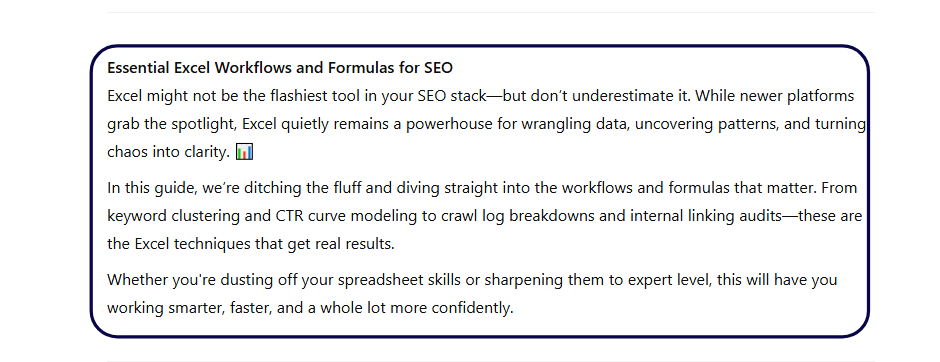
5. Factual Inaccuracies and Outdated Information
Ever heard of AI “hallucinating answers”. A study shows that 42.1% of web users have experienced inaccurate or misleading content in AI Overviews.
This includes citations to non-existent sources, outdated statistics, or information that was never accurate to begin with.
These errors can often go unnoticed in cases where proper data verification is not done and may prove disastrous in real life applications.
Check this screenshot of how this inaccuracies might manifest in an AI-genereated content that requires data:
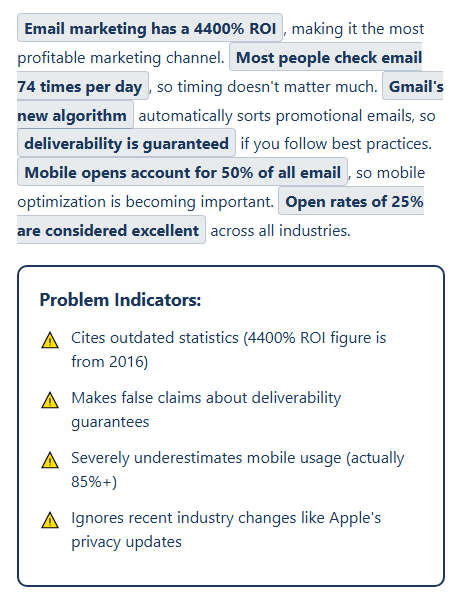
6. Excessive Length Without Substance
Sometimes these LLMs do generate verbose content that could communicate the same information more effectively in fewer words.
Especially for in-depth content, it might serve you a full page of additional words that do not add any meaning to the article.
The example below, for my article that required simple marketing hacks from ChatGPT, includes fluff (outlined in blue) that would make no difference to the article’s content when taken out.
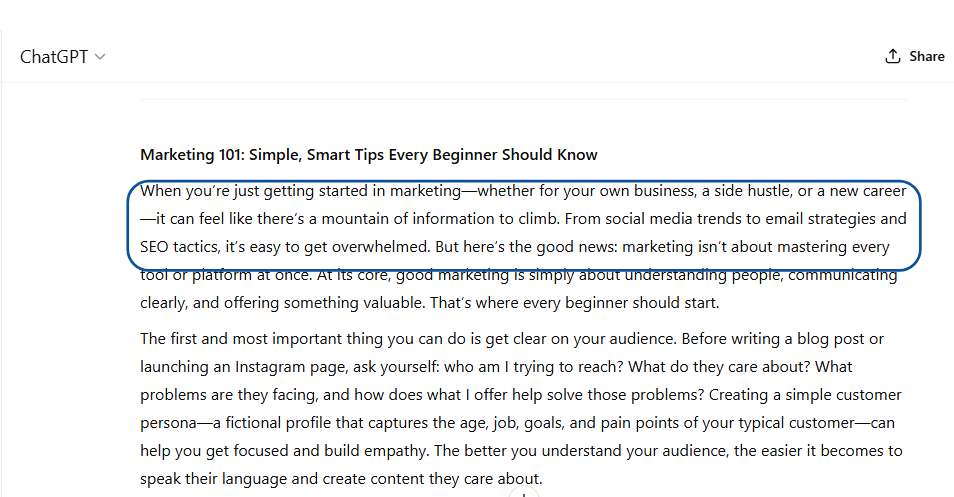
7. Lack of Practical Application or Actionability
This is especially applicable for instructional or educational content.
AI often fails to provide concrete steps, real-world examples or give practical guidance that readers can actually implement, creating a disconnect between the content’s apparent educational value and its actual utility.
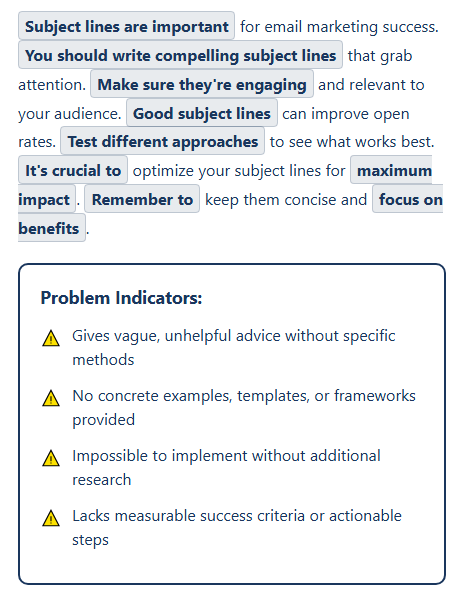
8. Inappropriate SEO Optimization
While using AI for SEO optimization can be a time saver, it might leave you with content that has keywords stuffed unnaturally and headings created solely for search engines rather than reader comprehension.
Example: “We offer digital marketing, SEO digital marketing, and digital marketing strategies in our digital marketing agency.” If you can hear the keyword when reading aloud and it sounds clunky or repetitive, it’s overused.
Impact of AI Slop on Content Creation
- Degradation of Content Quality Standards
As the internet becomes flooded with generic content, the baseline expectation for what constitutes acceptable content has shifted downward.
The abundance of mediocre content makes it more difficult for genuinely valuable content to stand out and reach its intended audience.
- Reduced Trust and Engagement from Audiences
Many users have developed a heightened sensitivity to content that feels artificial or generic, leading to decreased engagement rates, shorter time spent on content and reduced sharing behaviors.
This skepticism extends beyond obviously poor content to affect perceptions of all content, requiring creators to work harder to establish credibility and trust with their audiences.
- Search Engine Algorithm Adaptations
Search engines have begun implementing more sophisticated detection mechanisms and ranking factors that prioritize content demonstrating E-E-A-T, which is good challenge for content creators, who must now align their content to meet these quality standards.
- Information Saturation and Discovery Challenges
AI slop makes it increasingly difficult for users to find high-quality, relevant information.
This problem is particularly acute in educational and instructional content, where poor-quality information can have real-world consequences.
- Impact on Professional Industry
The availability of AI tools has led some creators to rely heavily on automation to create generic marketing copies that lead to loss of brand credibility and originality.
Conversely, successful creators have developed new skills in prompt engineering, AI collaboration and quality control.
Industry responses have varied, with many organizations implementing new editorial guidelines and content policies specifically designed to address AI slop.
Some platforms have introduced labeling requirements for AI-generated content, while others have adjusted their algorithms to better detect and deprioritize low-quality material.
How to Create High-Quality Content
Creating content that stands apart from AI slop requires a strategic approach that leverages AI tools effectively while maintaining human creativity, expertise, and judgment.
Here are some strategies to help you get a headstart in creating content that adds value:
Start with Human Expertise and Original Insight
Before touching any AI tool, invest time in learning your subject deeply.
- Stay updated on industry trends
- Conduct original research and studies
- Reflect on your personal experiences and technical expertise
- Document perspectives shaped by your own journey, things no AI or competitor could fabricate
Example:
Instead of “AI helps create informative content” in your article, go for “After leading 20 client workshops in fintech, I distilled insights into a guide on emerging compliance issues later refined using AI tools.”
Develop a Clear Content Strategy Before Writing
- Clarify who you’re writing for (Target audience)
- What challenges they face and what unique solution you’re offering
- Then build a brief that includes your main point, supporting arguments and the value your reader will walk away with.
Why it works:
Without this clarity, even advanced tools can lead you off track or toward generic fluff that do not reflect your authenticity as a brand.
Use AI for Research and Ideation Not Final Drafts
Use AI to brainstorm headlines, surface counterpoints or map out structural outlines.
Reserve the actual thinking; the opinions, conclusions and bold statements for yourself or brand perspective.
Instead of a flat response like this on your LinkedIn post “ChatGPT gave me a decent post on remote work” go for “I used ChatGPT to explore opposing views on remote productivity, then built a piece from my experience managing hybrid teams across 3 continents.”
Implement a Rigorous Fact-Checking Process
- When it comes to AI sources, trust but verify
- Cross-check data with primary sources like actual data from studies, dashboards etc.
Why it matters:
Accurate content isn’t just ethical, it’s also a signal of authority. Fact-checking improves your credibility and helps you learn the material more deeply.
Maintain a Consistent Voice and Tone
Even if AI drafts your first version, you must rewrite it to sound like you.
Your tone, humor, cadence and values should be present in every paragraph.
Why it matters:
People connect with people. A consistent, authentic voice builds trust, something AI-generated content often lacks.
Go Deep Instead of Broad
Avoid skimming topics. Instead, offer detailed analysis, practical examples and actionable tips on a specific angle of the subject.
As an introduction, “This post covers everything about marketing,” it is very general and lacks a certain hook for a reader.
Go for depth, e.g “This guide breaks down how micro-SaaS startups can use newsletter ads to grow their first 500 users.”
Incorporate Personal Experience and Case Studies
- Share what happened when you applied a tactic (objectives)
- Discuss what worked and what didn’t (KPIs)
- Share your opinions on what you’d do differently (Follow-up actions)
Why it works:
Readers want proof. Lived experience outperforms hypothetical advice and the details make your content resonate with your target audience.
Create a Quality Control Workflow
- Build in checkpoints before you publish
- Review for originality, clarity and alignment with your brand voice
- Ask a peer to point out what feels vague or too polished to be personal
Why it matters:
This added friction makes your content sharper and prevents generic phrasing from slipping through.
Engage in Continuous Learning
Commit to reading widely, writing often and upgrading your tools and knowledge to deepen your own expertise.
Take time to monitor or encourage feedback for your work and adapt accordingly.
Final Thoughts
Too often, we ignore the subtle warning signs in AI-generated content and skip the critical step of verifying what we read.
Success lies in understanding how to use AI tools strategically as enhancements rather than replacement of you.
The distinction between high-quality human-enhanced content and generic AI slop will likely become even more pronounced, as AI technology continues to evolve.
Creators and marketers who master this balance find themselves at a significant advantage by being able to produce higher-quality content more efficiently while maintaining the authenticity and depth that audiences value.

